Lowrance IFINDER GO2 ADVANCED USER GUIDE
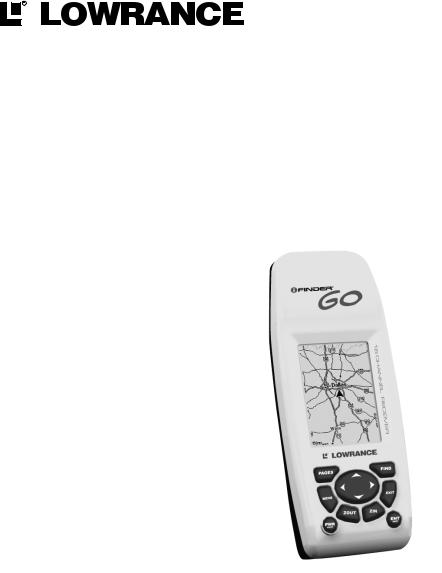
Pub. 988-0148-731
www.lowrance.com
iFINDER Go
Handheld Mapping GPS Receiver
Advanced Users Guide

Copyright © 2005 Lowrance Electronics, Inc.
All rights reserved.
No part of this manual may be copied, reproduced, republished, transmitted or distributed for any purpose, without prior written consent of Lowrance. Any unauthorized commercial distribution of this manual is strictly prohibited.
iFINDER Go and Lowrance® are registered trademarks of Lowrance Electronics, Inc. DURACELL is a registered trademark of Duracell, Inc. RAYOVAC is a registered trademark of Rayovac Corporation.
Energizer and e2 are registered trademarks of Energizer Holdings, Inc.
eXitSource Database, copyright 2001-2005 Zenrin Co. Ltd. Exit Authority and eXitSource are trademarks of
Zenrin Co. Ltd.
Lowrance Electronics may find it necessary to change or end our policies, regulations and special offers at any time. We reserve the right to do so without notice. All features and specifications subject to change without notice. All screens in this manual are simulated.
For free owner's manuals and the most current information on this product, its operation and accessories,
visit our web site:
www.lowrance.com
Lowrance Electronics Inc.
12000 E. Skelly Dr.
Tulsa, OK USA 74128-2486
Printed in USA.
Table of Contents |
|
Section 1: Read Me First!......................................................... |
1 |
Capabilities and Specifications: iFINDER Go, Go2 .................. |
2 |
How iFINDER Works ................................................................... |
3 |
Introduction to GPS and WAAS................................................... |
4 |
How to Use this Manual: Typographical Conventions................ |
6 |
Section 2: Installation & Accessories.................................... |
9 |
Power............................................................................................. |
9 |
Batteries .................................................................................... |
9 |
Cigarette Lighter Power Adapter........................................... |
10 |
R-A-M Bracket Mounting System ............................................ |
11 |
Other Accessories........................................................................ |
11 |
Section 3: Easy Mode Operation .......................................... |
13 |
Keypad......................................................................................... |
13 |
Power/lights on and off ............................................................... |
14 |
Main Menu .................................................................................. |
14 |
Pages ........................................................................................... |
15 |
Satellite Status Page .............................................................. |
15 |
Navigation Page...................................................................... |
16 |
Map Page................................................................................. |
18 |
iFINDER Easy Mode Quick Reference ...................................... |
20 |
Find Your Current Position........................................................ |
21 |
Moving Around the Map: Zoom & Cursor Arrow Keys ............. |
21 |
Selecting Any Map Item with the Cursor.................................. |
21 |
Searching..................................................................................... |
22 |
Set Home Waypoint .................................................................... |
23 |
Navigate Back Home .............................................................. |
24 |
Set Man Overboard (MOB) Waypoint........................................ |
24 |
Navigate Back to MOB Waypoint .......................................... |
25 |
Navigate to Cursor Position on Map.......................................... |
25 |
Navigate to a Map Place............................................................. |
26 |
Creating and Saving a Trail....................................................... |
27 |
Displaying a Saved Trail ........................................................ |
27 |
Navigating or Backtracking a Trail........................................... |
28 |
Visual Back Trailing ............................................................... |
28 |
Navigate a Back Trail............................................................. |
28 |
Clearing or Erasing a Trail .................................................... |
29 |
Switch to Advanced Mode........................................................... |
30 |
Switch Back to Easy Mode from Advanced Mode ................. |
30 |
Section 4: Advanced Mode Operation................................. |
31 |
Keypad......................................................................................... |
31 |
Power/lights on and off ............................................................... |
32 |
Main Menu .................................................................................. |
32 |
i |
|
Pages ........................................................................................... |
32 |
Satellite Status Page .............................................................. |
32 |
Position Page........................................................................... |
33 |
Navigation Page...................................................................... |
34 |
Map Page................................................................................. |
35 |
Moving Around the Map: Zoom & Cursor Arrow Keys ............. |
35 |
Find Distance From Current Position To Another Location .... |
36 |
Find Distance From Point to Point ............................................ |
36 |
Find Your Current Position........................................................ |
37 |
Icons............................................................................................. |
37 |
Create Icon on Map................................................................. |
37 |
Create Icon at Current Position ............................................. |
38 |
Delete an Icon ......................................................................... |
38 |
Navigate ...................................................................................... |
38 |
Navigate Back Home .............................................................. |
39 |
Navigate Back to Man Overboard Waypoint......................... |
39 |
Cancel Navigation................................................................... |
39 |
Navigate a Route..................................................................... |
39 |
Navigate to Cursor Position on Map...................................... |
39 |
Navigate to an Icon................................................................. |
39 |
Navigate to Map Place............................................................ |
39 |
Navigate to a Waypoint .......................................................... |
40 |
Navigate a Trail ...................................................................... |
40 |
Backtrack a Trail .................................................................... |
41 |
Routes.......................................................................................... |
41 |
Create and Save a Route ........................................................ |
41 |
Delete a Route......................................................................... |
43 |
Searching..................................................................................... |
43 |
Find Any Item Selected by Map Cursor................................. |
44 |
Find Interstate Highway Exits .............................................. |
44 |
Find Map Places...................................................................... |
46 |
Find Streets or Intersections.................................................. |
47 |
Find Waypoints ....................................................................... |
49 |
Switch to Easy Mode................................................................... |
51 |
Switch Back to Advanced Mode from Easy Mode ..................... |
51 |
Trails ........................................................................................... |
51 |
Create and Save a Trail.......................................................... |
51 |
Clear a Trail ............................................................................ |
51 |
Delete a Trail .......................................................................... |
52 |
Edit a Trail Name ................................................................... |
52 |
Utilities........................................................................................ |
52 |
Alarm Clock............................................................................. |
52 |
Sun/Moon Rise & Set Calculator............................................ |
52 |
ii |
|
Trip Calculator........................................................................ |
52 |
Trip Down Timer..................................................................... |
52 |
Trip Up Timer ......................................................................... |
52 |
Waypoints.................................................................................... |
52 |
Create a Waypoint .................................................................. |
52 |
Create Waypoint on Map .................................................... |
52 |
Create Waypoint at Current Position ................................ |
53 |
Create a Man Overboard Waypoint ................................... |
53 |
Create a Waypoint by Average Position ............................ |
53 |
Create a Waypoint by Projecting a Position ...................... |
53 |
Select a Waypoint ................................................................... |
54 |
Delete a Waypoint................................................................... |
54 |
Edit a Waypoint (Name, Symbol, Position or Altitude) ........ |
54 |
Section 5: System & GPS Setup Options ............................ |
55 |
Alarms ......................................................................................... |
55 |
Auto Satellite Search.................................................................. |
56 |
Com Port Configuration ............................................................. |
57 |
Coordinate System Selection...................................................... |
57 |
Map Fix.................................................................................... |
59 |
Customize Page Displays ........................................................... |
60 |
Customize Position or Navigation Page................................. |
60 |
Customize Map Page .............................................................. |
60 |
GPS Simulator ............................................................................ |
61 |
Simulating Trail or Route Navigation ................................... |
61 |
Map Auto Zoom........................................................................... |
62 |
Map Data..................................................................................... |
62 |
Earth Map Detail .................................................................... |
63 |
Pop-up Map Info...................................................................... |
63 |
Fill Land Gray......................................................................... |
63 |
Map Overlays (Range Rings; Lat/Long Grid) ........................ |
63 |
Map Detail Category Selection................................................... |
64 |
Map Orientation ......................................................................... |
64 |
Pop-up Help................................................................................. |
65 |
Reset Options .............................................................................. |
66 |
Require WAAS ............................................................................ |
66 |
Screen Contrast and Brightness ................................................ |
67 |
Set Language .............................................................................. |
69 |
Set Local Time ............................................................................ |
69 |
Software Version Information.................................................... |
70 |
Track Smoothing......................................................................... |
71 |
Trail Options ............................................................................... |
71 |
Flash Trails on Screen Option................................................ |
72 |
Update Trail Option................................................................ |
72 |
iii |
|
Update Trail Criteria (Auto, Time, Distance) ....................... |
72 |
Trail Update Rate (Time, Distance)....................................... |
73 |
Delete Trail ............................................................................. |
73 |
New Trail................................................................................. |
74 |
Trail Visible/Invisible and Other Trail Options .................... |
74 |
Units of Measure......................................................................... |
74 |
Section 6: Supplemental Material ....................................... |
76 |
Index........................................................................................... |
78 |
WARNING!
A CAREFUL NAVIGATOR NEVER RELIES ON ONLY ONE METHOD TO OBTAIN POSITION INFORMATION.
CAUTION
When showing navigation data to a position (waypoint), a GPS unit will show the shortest, most direct path to the waypoint. It provides navigation data to the waypoint regardless of obstructions. Therefore, the prudent navigator will not only take advantage of all available navigation tools when traveling to a waypoint, but will also visually check to make sure a clear, safe path to the waypoint is always available.
WARNING!
When a GPS unit is used in a vehicle, the vehicle operator is solely responsible for operating the vehicle in a safe manner. Vehicle operators must maintain full surveillance of all pertinent driving, boating or flying conditions at all times. An accident or collision resulting in damage to property, personal injury or death could occur if the operator of a GPS-equipped vehicle fails to pay full attention to travel conditions and vehicle operation while the vehicle is in motion.
iv
Section 1: Read Me First!
How this manual can get you out on the road, fast!
Welcome to the exciting world of GPS satellite navigation! We know you're anxious to begin finding your way with this advanced technology, but we have a favor to ask. Before you grab the batteries and head outside, please give us a moment or two to explain how our manual can help you get the best performance from this remarkable little GPS unit.
First, we want to thank you for buying an iFINDER Go. Whether you're a first-time user or a professional navigator, you'll discover that the iFINDER is a true pocket-sized, full-featured mapping GPS receiver. No other consumer GPS mapping system on the market offers so much information and so many features in one package.
Our goal for this book is to get you on the road or out to the woods and water fast, with a minimum of fuss. Like you, we'd rather spend more time traveling, and less time reading the manual!
So, we designed our book so that you don't have to read the whole thing from front to back for the information you want. At the start (or end) of each segment, we'll tell you what content is coming up next. If it's a concept you're already familiar with, we'll show you how and where to skip ahead for the next important topic. We've also made it easy to look up any tips you may need from time to time. Here's how:
The manual is organized into six sections. This first section is an introduction to Lowrance GPS. It tells you the basics you need to know before you can make the unit look around and tell you where you are.
Section 2 will help you get the batteries correctly installed in your iFINDER. We'll also tell you about some of the accessories available for your unit.
Section 3 is the heart of our book, Easy Mode Operation. It will introduce you to the basic GPS functions. We lead off this section with a onepage Easy Mode Quick Reference. (If you've already figured out how to load the batteries yourself, and you just can't wait any longer, turn to the Quick Reference on page 20 and head outside with your iFINDER!)
The rest of Section 3 contains short, easy-to-scan lessons that follow one another in chronological order. They're all you'll need to know to find your way on the water or in the wilderness quickly.
Easy Mode operation will meet the navigation needs of many users. But, after you've learned the basics (or if you already have some GPS experience), you may want to try out some of iFINDER's many ad-
1
vanced navigation features. That brings us to Section 4, Advanced Mode Operation. After we introduce the Advanced Mode menus and submenus, this section contains the rest of iFINDER's command functions, organized in alphabetical order.
When you come to a GPS menu command on the iFINDER screen, you can look it up in the manual by skimming over the table of contents or index, just flipping through Section 3 or scanning through the command portion of Section 4.
iFINDER is ready to use right out of the box, but you can fine tune and customize its operation with dozens of options. We describe how to use general system options along with GPS options in Section 5, System Setup and GPS Setup Options. This section covers both Easy Mode and Advanced Mode options.
Finally, in Section 6, we offer Supplemental Material, including a list of the GPS datums used, warranties, and customer service information.
Now, if you're into the fine details, glance over the next segment on specifications to see just how much GPS power you hold in your hand. It's important to us (and our power users), but if you don't care how many waypoints iFINDER can store or how long the batteries last, skip ahead to important information on how iFINDER works, on page 3.
Capabilities and Specifications: iFINDER Go, Go2
|
General |
Display:............................ |
2" (51 mm) diagonal high contrast Film Su- |
|
perTwist, 16-level grayscale. |
Resolution:...................... |
200V pixel x 140H pixel resolution; 28,000 |
|
total pixels. |
Backlighting:.................. |
Amber LED for night and low-light viewing. |
Input power:................... |
3 volts DC (two 1.5v AA batteries); operates |
|
up to 61 hours on batteries with no back- |
|
light. Operates for 30 hours with backlight |
|
set to half bright and for 18 hours with |
|
backlight set to full bright. |
Case size: ............................ |
pocket-size, 5.15" H x 2.12" W x 1.25" D (131 x |
|
58 x 32 mm); waterproof to IPX7 standards. |
Weight:............................. |
5.7 ounces (162 grams) with batteries. |
Back-up memory: .......... |
Built-in memory stores GPS data for dec- |
|
ades. User settings are stored when the unit |
|
is turned off. |
2
Map & data memory: .... |
Go has 32 MB of built-in memory for the map |
|
and GPS data; Go2 has 64 MB. |
Languages:...................... |
10; menu selectable by user. |
|
GPS |
Receiver/antenna:......... |
Internal; 16 parallel channel GPS/WAAS. |
Background map:.......... |
Go contains low-detail world map and me- |
|
dium-detail USA map. Go2 contains same |
|
maps plus high-detail USA shoreline data. |
|
Go2 International contains world reference |
|
map. For complete description of data con- |
|
tained in these maps, see information else- |
|
where in this manual. |
Position updates: .......... |
Every one second. |
Man Overboard:............. |
MOB feature precisely marks man overboard |
|
location with special icon, then automatically |
|
displays navigation data to that position. |
Screen alarms: ............... |
Arrival/off-course/destination passed/anchor. |
Graphic symbols for |
|
waypoints or event |
|
marker icons: ................. |
42. |
Position points: ............. |
1,000 waypoints; 1,000 event marker icons. |
Routes:............................. |
100; up to 100 waypoints per route. |
Plot Trails:...................... |
100 savable; up to 9,999 points per trail. |
Zoom range:.................... |
40 map zoom ranges; 0.02 to 4,000 miles. |
How iFINDER Works
You'll navigate faster and easier if you understand how iFINDER scans the sky to tell you where you are on the earth — and, where you're going. (But if you already have a working understanding of GPS receivers and the GPS navigation system, skip on ahead to Section 2, Installation & Accessories on page 9. If you're new to GPS, read on, and you can later impress your friends with your new-found knowledge.)
First, think of your iFINDER as a small but powerful computer. (But don't worry — we made iFINDER easy to use, so you don't need to be a computer expert to find your way!) The iFINDER includes a keypad and a screen with menus so you can tell it what to do. The screen also lets iFINDER show your location on a moving map, as well as point the way to your destination.
3
This pocket-sized computer also contains an antenna and specialized scanning receiver, something like your car radio. But instead of your favorite dance tunes, this receiver tunes in to a couple of dozen GPS satellites circling the earth. (It will also listen in to the WAAS satellites in orbit, but more about that in the upcoming segment introducing you to GPS and WAAS.)
iFINDER listens to signals from as many satellites as it can "see" above the horizon, eliminates the weakest signals, then computes its location in relation to those satellites. Once iFINDER figures its latitude and longitude, it plots that position on the moving map shown on the screen. While the screen is updated once a second, your iFINDER is making these internal calculations and determining its position several times a second!
The performance doesn't stop there. Stored in the permanent memory of each iFINDER is a basic background map of the entire world. We lock it in here at the factory — you can't change or erase this map.
Another portion of iFINDER's onboard memory is devoted to recording GPS navigation information, which includes waypoints, event marker icons, trails and routes. This lets you look back the way you came. Think of this data storage like the hard drive memory in a computer or a tape in a cassette tape recorder. You can save several different GPS data files, erase 'em and record new ones, over and over and over again.
Introduction to GPS and WAAS
Well, now you know the basics of how iFINDER does its work. You might be ready to jump ahead to Section 2, Installation & Accessories, on page 9, so you can install the batteries. Or you might want to see how our text formatting makes the manual tutorials easy to skim. If that's the case, move on to "How to Use This Manual" on page 6. But, if you want to understand the current state of satellite navigation, look over this segment describing how GPS and its new companion WAAS work together to get you where you're going.
The Global Positioning System (GPS) was launched July 17, 1995 by the United States Department of Defense. It was designed as a 24- hour-a-day, 365-days-a-year, all weather global navigation system for the armed forces of the U.S. and its allies. Civilian use was also available at first, but it was less accurate because the military scrambled the signal somewhat, using a process called Selective Availability (SA). GPS proved so useful for civilian navigation that the federal government discontinued SA on May 2, 2000, after the military developed
4
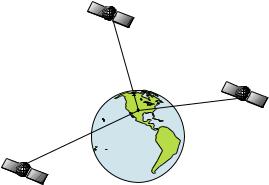
other methods to deny GPS service to enemy forces. Reliable accuracy for civilian users jumped from 100 meters (330 feet) under SA to the present level of 10 to 20 meters (about 30 to 60 feet.)
Twenty-four satellites orbit 10,900 nautical miles above the Earth, passing overhead twice daily. A series of ground stations (with precisely surveyed locations) controls the satellites and monitors their exact locations in the sky. Each satellite broadcasts a low-power signal that identifies the satellite and its position above the earth. Three of these satellites are spares, unused until needed. The rest virtually guarantee that at least four satellites are in view nearly anywhere on Earth at all times.
A minimum of three satellites are required to determine a 2D fix.
The system requires signal reception from three satellites in order to determine a position. This is called a 2D fix. It takes four satellites to determine both position and elevation (your height above sea level — also called altitude.) This is called a 3D fix.
Remember, the unit must have a clear view of the satellites in order to receive their signals. Unlike radio or television signals, GPS works at very high frequencies. These signals can be easily blocked by trees, buildings, an automobile roof, even your body.
Like most GPS receivers, iFINDER doesn’t have a compass or any other navigation aid built inside. It relies solely on the signals from the satellites to calculate a position. Speed, direction of travel, and distance are all calculated from position information. Therefore, in order for iFINDER to determine direction of travel, you must be moving and the faster, the better. This is not to say that it won’t work at walking or trolling speeds — it will. There will simply be more "wandering" of the data shown on the display.
GPS is plenty accurate for route navigation, but the U.S. Federal Aviation Administration has special needs for aircraft traffic control that go
5
beyond basic GPS. The FAA has a plan under way to boost GPS performance even further with its Wide Area Augmentation System, or WAAS. This GPS add-on will include a time control element that will help airliners fly closer together while avoiding collisions. In addition to carefully spacing airplanes along travel corridors, WAAS will eventually make instrument landings and takeoffs more accurate as it replaces existing aviation navigation systems.
Non-aviators can use WAAS signals to make their GPS navigation even more accurate. Your iFINDER receives both GPS and WAAS signals. However, WAAS has some limits you should know about.
First, the U.S. government has not completed construction of the WAAS system, so it is not yet fully operational. The ground stations are in place, but only a few of the needed WAAS satellites have been launched.
WAAS can boost the accuracy of land GPS navigation, but the system is designed for aircraft. The satellites are in a fixed orbit around the Equator, so they appear very low in the sky to someone on the ground in North America. Aircraft and vessels on open water can get consistently good WAAS reception, but terrain, foliage or even large man-made structures frequently block the WAAS signal from ground receivers.
You'll find that using your GPS receiver is both easy and amazingly accurate. It’s easily the most accurate method of electronic navigation available to the general public today. Remember, however, that this receiver is only a tool. Always have another method of navigation available, such as a map or chart and a compass.
Also remember that this unit will always show navigation information in the shortest line from your present position to a waypoint, regardless of terrain! It only calculates position, it can’t know what’s between you and your destination, for example. It’s up to you to safely navigate around obstacles, no matter how you’re using this product.
How to Use this Manual: Typographical Conventions
Many instructions are listed as numbered steps. The keypad and arrow "keystrokes" appear as boldface type. So, if you're in a real hurry (or just need a reminder), you can skim the instructions and pick out what menu command to use by finding the boldface command text. The following paragraphs explain how to interpret the text formatting for those commands and other instructions:
6
Arrow Keys
The arrow keys control the movement of dotted cross-hair lines on your mapping screen called the cursor. The arrow keys also help you move around the iFINDER menus so you can execute different commands. They are represented by symbols like these, which denote the down arrow key, the up arrow, the left arrow and the right arrow: ↓ ↑ ← →.
Keyboard
The other keys perform a variety of functions. When the text refers to a key to press, the key is shown in bold, sans serif type. For example, the "Enter/Save" key is shown as ENT and the "Menu" key is shown as MENU.
Menu Commands
A menu command or a menu option will appear in small capital letters, in a bold sans serif type like this: ADVANCED MODE. These indicate that you are to select this command or option from a menu or take an action of some kind with the menu item. Text that you may need to enter or file names you need to select are shown in italic type, such as trail name.
Instructions = Menu Sequences
Most functions you perform with iFINDER are described as a sequence of key strokes and selecting menu commands. We've written them in a condensed manner for quick and easy reading.
For example, instructions for backtracking a trail in Easy Mode would look like this:
1.Press MENU|↓ to NAVIGATE TRAIL|ENT.
2.Now, begin moving and follow your iFINDER.
Translated into complete English, step 1 means: "Press the Menu key. Next, press the down arrow key to scroll down the menu and select (highlight) the Navigate Trail menu command. Finally, press the Enter key."
Also note that throughout this text, we will refer to the iFINDER Go as iFINDER, or simply as the unit.
7
Notes
8
Section 2:
Installation & Accessories
Power
The iFINDER operates from two AA batteries or on 3 volts DC using an optional external power cable with a cigarette lighter adapter. If the power cable is used, the iFINDER automatically switches to it if the external power is greater than the battery voltage. If the external power fails, the unit automatically switches to the batteries.
Flash memory and an internal lithium battery will keep your stored data safe and accessible for the life of the product.
Batteries
The unit requires two 1.5-volt AA batteries. We recommend that you use alkaline batteries for the best trade-off between battery life and cost. We recommend DURACELL brand, but other brands will work. If you're looking for an extended-life battery, the Duracell ULTRA battery has performed well in our tests.
You can also use rechargeable AA alkaline batteries, such as those made by RAYOVAC , or rechargeable AA nickel metal hydride (NiMH) batteries. We do not recommend nickel cadmium (NiCd) rechargeable batteries because you will get poor battery life from them.
Rechargeable alkaline batteries will not last as long as standard alkaline batteries. NiMH batteries are rechargeable, however, and should give you suitable battery life.
Do not mix different battery types. Mixing battery types may cause leakage. (For example, don’t use both alkaline and NiMH batteries at the same time, and don't use standard alkalines with rechargeable alkalines.)
Battery Installation
Turn the unit over so that the back is facing you. Use your thumb to press the latch on the battery compartment cover toward the bottom of the unit.
9

Release the latch to remove iFINDER battery cover.
When the latch clicks free, lift the battery compartment cover away from the unit. Install the batteries according to the decal in the battery compartment, which shows the correct polarity.
Replace the battery compartment cover. Align the two tabs in the bottom of the cover with two small sockets in the base of the unit. Then fold the cover into place and make sure the latch clicks closed.
Replace battery compartment cover.
Align tabs with slots, then snap cover in place.
Cigarette Lighter Power Adapter
To use external DC power: Plug the power cable's cigarette lighter adapter into a cigarette lighter receptacle. Next, slide the other connector over the power contacts on the bottom of the iFINDER case.
10
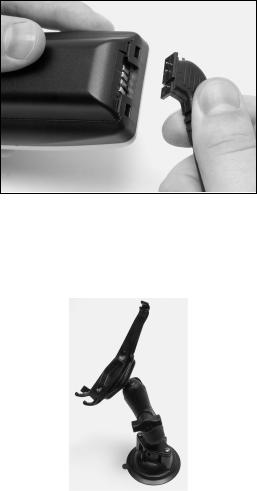
Attach external power cable to iFINDER.
R-A-M Bracket Mounting System
A R-A-M mounting bracket is available for your iFINDER. The mounting arm and cradle can swivel on a ball for easy viewing in any type of vehicle.
R-A-M mounting system.
Other Accessories
Other iFINDER accessories include a belt holster with a see-through cover, as well as other cable connections. If these accessories are not available from your dealer, see the accessory ordering information on the inside back cover of this manual.
11
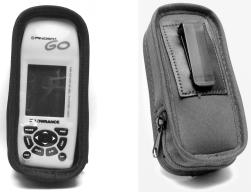
See-through belt holster for the iFINDER Go.
12
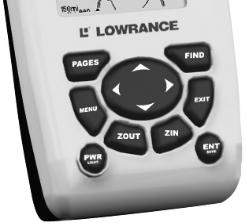
Section 3:
Easy Mode Operation
This section addresses Easy Mode operation for iFINDER's main GPS functions. The principles are the same in both operating modes, so this discussion also serves as a good introduction to Advanced Mode work.
Before you turn on iFINDER and find where you are, it's a good idea to learn about the different keys, the three Page screens and how they all work together. BUT, if you just can't wait to get outside, grab the batteries and turn to the one-page Quick Reference on page 20.
Keypad
|
|
7 |
2 |
|
|
|
4 |
6 |
|
|
|
3 |
|
|
8 |
9 |
5 |
1 |
|
|
iFINDER keypad.
1.PWR/LIGHT (Power & Light) – The PWR key turns the unit on and off and activates the backlight. Turn off the unit by pressing and holding the PWR key for 3 seconds.
2.PAGES – Pressing this key switches the unit between the three different page screens in Easy Mode. (Satellite, Navigation and Map.) Each page represents one of the unit's major operation modes.
3.MENU – Press this key to show the menus, which allow you to select or adjust a feature from a list.
4.ARROW KEYS – These keys are used to navigate through the menus, make menu selections, move the map cursor and enter data.
5.ENT/SAVE (Enter & Save) – This key allows you to save data, accept values or execute menu commands.
13
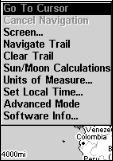
6.EXIT – The Exit key lets you return to the previous screen, clear data or erase a menu.
7.FIND – The Find key launches the iFINDER search menus.
8.ZOUT – (Zoom Out) – This key lets you zoom the screen out to see a larger geographic area on the map. Less detail is seen as you zoom out.
9.ZIN – (Zoom In) – This key lets you zoom the screen in to see greater detail in a smaller geographic area on the map.
Power/lights on and off
To turn on the unit, press PWR. To turn on the backlight, press PWR again. Pressing PWR once again will turn off the backlight. (Press EXIT to clear any message or alarm displays.)
Turn off the unit by pressing and holding the PWR key for 3 seconds.
Main Menu
Easy Mode has a single Main Menu, which contains some function commands and some setup option commands. The tutorial lessons in this section will deal only with functions, the basic commands that make iFINDER do something. iFINDER will work fine for these lessons right out of the box with the factory default settings. But, if you want to learn about the various options, see Sec. 5, System Setup and GPS Setup Options.
Main Menu, Easy Mode.
The Main Menu commands and their functions are:
Go To Cursor command: navigates to the current cursor position on the map
Cancel Navigation command: turns off the navigation command after you have reached the end of a back trail or your destination waypoint, Point of Interest or map cursor location.
14
Screen command: changes the contrast or brightness of the display screen.
Sun/Moon command: finds the rising and setting time of the sun and the moon.
Units of Measure command: changes the speed or distance units. Also used to change the heading and time formats.
Set Local Time command: sets the time for your local time zone.
Advanced Mode command: used to switch from Easy Mode to Advanced Mode. Easy Mode shows only the most commonly used features to simplify the interface and simplify operation.
Software Info command: shows the product name and software version of the unit's operating system software, as well as copyright notices.
Pages
Easy Mode has three Page displays that represent the three major operating modes. They are the Satellite Status Page, the Navigation Page and the Map Page. They are accessed by pressing the PAGES key. Pressing PAGES repeatedly scrolls among the three screens in an endless circular loop.
Satellite Status Page
This Page, shown in the following images, provides detailed information on the status of iFINDER's satellite lock-on and position acquisition. To get to the Satellite Status Page: press PAGES repeatedly until the page you want appears.
No matter what page you are on, a flashing current position indicator/question mark symbol and flashing GPS data displays indicate that satellite lock has been lost and there is no position confirmed. This page shows you the quality and accuracy of the current satellite lock-on and position calculation.
WARNING:
Do not begin navigating with this unit until the numbers have stopped flashing!
15
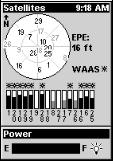
Satellite Page showing active satellites with varying degrees of signal strength.
This screen shows a graphical view of the satellites that are in view. Each satellite is shown on the circular chart relative to your position. The point in the center of the chart is directly overhead. The small inner ring represents 45° above the horizon and the large ring represents the horizon. North is at the top of the screen. You can use this to see which satellites are obstructed by obstacles in your immediate area if you hold the unit facing north.
The GPS receiver is tracking satellites that are in bold type. The receiver hasn't locked onto a satellite if the number is grayed out, therefore it isn't being used to solve the position.
Beneath the circular graph are the bar graphs, one for each satellite in view. Since the unit has twelve channels, it can dedicate one channel per visible satellite. The taller the bar on the graph, the better the unit is receiving the signals from the satellite.
The "Estimated Position Error" (horizontal position error) shown in the upper right corner of the screen is the expected error from a benchmark location. In other words, if the EPE shows 50 feet, then the position shown by the unit is estimated to be within 50 feet of the actual location. This also gives you an indicator of the fix quality the unit currently has. The smaller the position error number, the better (and more accurate) the fix is. If the position error flashes dashes, then the unit hasn't locked onto the satellites, and the number shown isn't valid.
Navigation Page
This Page has a compass rose. It shows your direction of travel and the direction to a recalled waypoint. The navigation screen looks like the one in the following image when you're not navigating to a waypoint or other destination. No graphic course information is displayed. Your position is shown by an arrow in the center of the screen. Your trail his-
16
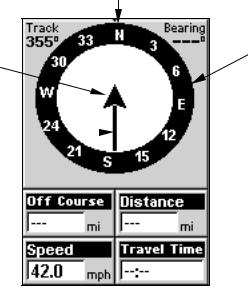
tory, or path you've taken, is depicted by the line extending from the arrow. The arrow pointing down at the top of the compass rose indicates the current track (direction of travel) you are taking.
Track or compass heading indicator, showing direction of travel
Present |
Compass |
|
rose |
||
position |
|
|
arrow |
|
|
Trail line |
|
|
|
|
|
Navigation  information
information
display
Navigation Page, recording a trail, traveling due north. Page looks like this when not navigating to a waypoint, or following a route or trail.
When navigating to a waypoint or following a route, the Navigation screen looks like the one shown in the following image. Your ground speed, track, distance and bearing to waypoint, and course are all shown digitally on this screen. Closing speed is also known as velocity made good. It's the speed that you're making towards the waypoint.
The current cross track error is shown in the Off Course line. This is the distance you are off-course to the side of the desired course line. The course line is an imaginary line drawn from your position when you started navigating to the destination waypoint. It's shown on the steering screen as a vertical dotted line.
Lines on either side of the present position show the current cross track error range. The default for the cross track error range is 0.20 mile. For example, if the present position symbol touches the right cross track error line, then you are .20 mile to the right of the desired course. You need to steer left to return to the desired course. You can use the ZIN or ZOUT keys to change the cross track error range. A circular symbol depicting your destination (waypoint) appears on the screen as you approach the waypoint as shown on the screen below.
17
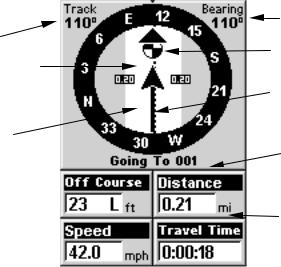
Travel Time is the time that it will take to reach your destination at your present closing speed. Arrival Time is the local time that it will be when you arrive at the destination, based upon your present closing speed and track.
Current track or |
|
Compass bearing |
heading, shown |
|
to destination |
in degrees |
|
Bearing |
Waypoint |
|
|
symbol |
|
arrow |
|
|
Trail line |
Cross track |
|
Destination |
error range |
|
|
(off course |
|
name |
indicator) |
|
|
|
|
Navigation |
|
|
information |
|
|
display |
|
|
|
Navigation Page, backtracking a trail. Driver is headed due east (a 110º track) toward a waypoint 110º (bearing) away. The cross track error range (white corridor) is 0.20 miles either side of the course. The driver is headed toward waypoint 001, which is 0.21 miles away. The vehicle is very nearly on course (off course 23 feet). Traveling at a speed of 42 mph, the driver will arrive at the waypoint in 18 seconds.
Map Page
The map screens show your course and track from a "bird's-eye" view. By default, this unit shows the map with north always at the top of the screen. (This can be changed using options in Advanced Mode. See the topic Map Orientation, in Sec. 5.) If you're navigating to a waypoint, the map also shows your starting location, present position, course line and destination.
NOTE:
When our text says, "navigating to a waypoint," we really mean navigation to any selected item, whether it is a waypoint you made, a map feature or a map place such as a city or town.
Using the map is as simple as pressing the PAGES key. A screen similar to those in following images appears. The arrow flashing in the center of the screen is your present position. It points in the direction you're traveling. The solid line extending from the arrow is your plot trail, or path you've taken. (Remember, a flashing question mark on the arrow symbol or flashing text displays means iFINDER has not yet calculated a position.)
18
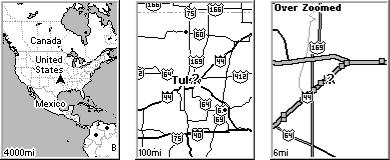
The map zoom range is the distance across the screen. This number shows in the lower left corner of the screen. In the first example below left, the range is 4,000 miles from the left edge of the map to the right edge of the map.
The Zoom In and Zoom Out keys zoom the map to enlarge or reduce its coverage area and the amount of mapping detail shown. There are 39 available map zoom ranges, from 0.02 miles to 4,000 miles.
Far left, Map Page opening screen. Center, zoomed to 100 miles and right, zoomed to 6 miles. Over Zoomed means you have reached the detail limits in an area covered only by the basic background map.
Zooming in any closer will reveal no more map details.
The map data loaded in your iFINDER Go contains a low-detail world map and a medium detail USA map. The Go2 model contains the same maps plus high detail USA lake, river and coastal shoreline data.
The low-detail world map contains some large cities and most country political boundaries. The medium-detail U.S. map contains: all incorporated cities; shaded metropolitan areas; county boundaries; some major city streets; Interstate, U.S. and state highways; lakes and streams and more than 60,000 navigation aids and 10,000 wrecks and obstructions in U.S. coastal and Great Lakes waters. The map also contains exit services information for Interstate highways.
The iFINDER Go2 International contains a world reference map with basic worldwide coverage of country political boundaries, major inland lakes, rivers and coastal waters, plus key cities, and major and minor highways.
The following page contains an 11-step quick reference for Easy Mode operation. If you don't want to carry the manual with you as you practice with iFINDER, you might consider photocopying this quick reference page and tucking it into your pocket.
19
iFINDER Easy Mode Quick Reference
1.Install two AA batteries in the battery compartment on back of case.
2.To turn on iFINDER, press and release PWR key.
3.Opening screen displays map of North America at the 4,000 mile zoom range. Rotate through the three main Page screens (Map Page, Satellite Status Page, Navigation Page) by repeatedly pressing PAGES key. Switch Pages to display Satellite Status Page.
4.Wait while unit locates satellites and calculates current position. Process is visible on Satellite page. This takes an average of 1 minute or less under clear sky conditions (unobstructed by terrain or structures). When the unit acquires position, a position acquired message appears.
5.With position acquired, press PAGES key to display Map Page, which shows a bird's eye view of the earth. You can move around the map by:
Zoom in closer to see greater detail: press ZIN (zoom in key.) Zoom out to see more area, less detail: press ZOUT (zoom out key.) Scroll map north, south, east or west using arrow keys ↑ ↓ → ←.
To stop scrolling and return to current position on map, press EXIT key.
6.Set Home waypoint at your current position so you can navigate back here: press ENT|ENT.
7.Zoom/scroll map to find a nearby object or location. Use arrow keys to center cursor cross-hair over the map object or location.
8.To navigate to the selected location: press MENU|ENT|EXIT. Follow steering arrow on Map Page or compass bearing arrow on Navigation Page.
9.At destination, Arrival Alarm goes off; to clear it, press EXIT. Cancel navigation: press MENU|↓ to CANCEL NAVIGATION|ENT|← to YES|ENT.
10.Navigate back home by Go To Home or Navigate Trail. Go Home: press FIND|ENT; follow navigation arrows. Trail: press MENU|↓ to NAVIGATE TRAIL|ENT. Wait while route is calculated, then follow arrows.
11.Back home, Arrival Alarm goes off; press EXIT. Cancel navigation:
press MENU|↓ to CANCEL NAVIGATION|ENT|← to YES|ENT.
20
Find Your Current Position
Finding your current position is as simple as turning iFINDER on. Under clear sky conditions, the unit automatically searches for satellites and calculates its position in approximately one minute or less.
NOTE:
"Clear sky" means open sky, unobstructed by terrain, dense foliage or structures. Clouds do not restrict GPS signal reception.
If for some reason satellite acquisition takes longer, you may be inside a structure or vehicle or in terrain that is blocking signal reception. To correct this, be sure you are positioned so that the unit has as clear a view of the sky as possible, then turn the unit off and back on again.
Moving Around the Map: Zoom & Cursor Arrow Keys
The map is presented from a bird's eye view perspective. The current zoom range shows in the lower left corner of the screen.
1.Press the ZIN key (zoom in) to move in closer and see greater detail in a smaller geographic area.
2.Press the ZOUT key (zoom out) to move farther away and see less map detail, but a larger geographic area.
When you are walking or riding in a vehicle, the map will automatically move as you move. This keeps your current location roughly centered on the screen.
You can manually pan or scroll the map northward, southward, eastward or westward by using the arrow keys, which launches the crosshair map cursor. This allows you to look at map places other than your current position. To clear the cursor, press EXIT, which jumps the map back to the current position or the last known position.
Tip:
Use the cursor to determine the distance from your current position (or last known position, when working indoors) to any map object or location. Simply use the arrow keys to position the cursor over the object or place. The distance, measured in a straight line, appears in the data box at the bottom of the map. Press EXIT to clear the cursor.
Selecting Any Map Item with the Cursor
1. Use the zoom keys and the arrow keys to move around the map and find the item you wish to select.
21

2. Use the arrow keys and center the cursor cross-hair on the desired object. On most items, a pop-up box will give the name of the selected item.
You will also notice a black ring surrounds the item as it becomes selected. Once that happens, if you press FIND the Find Menu will pop up with an extra option at the top of the list: SELECTED ITEM. Press ENT to see the Waypoint Information screen for the selected item.
Searching
Now that you've seen how iFINDER can find where you are, let's search for something somewhere else. Searching is one of the most powerful features in the Lowrance GPS product line.
In this example, we'll look for the body of water. For more information on different types of searches, refer to Sec. 4, Advanced Mode Operation.
After iFINDER has acquired a position:
1. Press FIND|↓ to MAP PLACES|ENT|↓ to WATER|ENT.
Find Map Places Menu, left, category menu with water selected, center, and Find By Nearest menu, right.
2.A window will pop up giving you the option of choosing a body of water by name or viewing a list of the locations nearest you. For this example, we'll search by nearest, so press ENT. A list appears, with the closest body of water at the top of the list, and the farthest at the bottom of the list. The nearest is highlighted.
3.If you wish, you could scroll ↑ or ↓ here to select another location, but for now we will just accept the nearest one. Press ENT.
4.The Map Place's Waypoint Information screen appears. If you
wanted to navigate there, you could press Enter, since the Go To command is highlighted. But we just want to see it on the map, so press → to FIND ON MAP|ENT.
22
